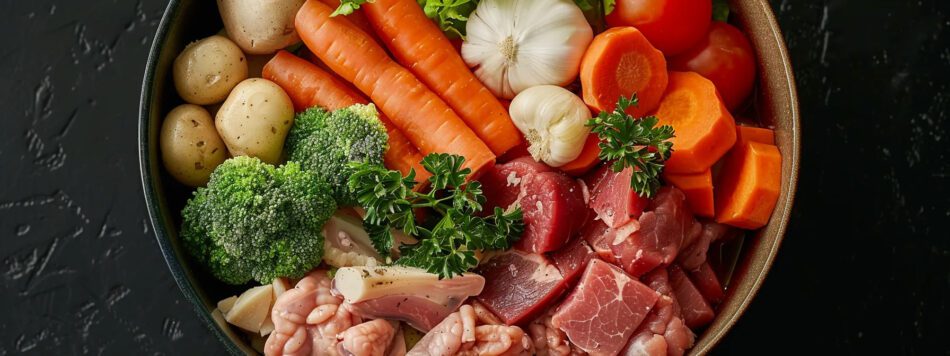As pet owners increasingly search for the best diet for their furry friends, the discussion around raw dog food is surging in popularity. Many believe that a raw food diet mimics the ancestral eating habits of dogs, potentially leading to a leaner body mass, healthier skin, and improved energy levels. These benefits are just the tip of the iceberg when it comes to understanding the potential of this natural approach to canine nutrition. Below, we’ll delve into the principles of a raw diet, its benefits, vital nutrients, brand evaluation, and how to safely transition your dog onto this path.
Evaluating and Choosing the Best Raw Dog Food Brands

When choosing a raw dog food brand, prioritize those with ethically sourced, high-quality ingredients like human-grade meats and responsibly raised or wild-caught sources. Ensure the brand adheres to AAFCO guidelines for nutritional completeness, balancing proteins, fats, vitamins, and minerals to meet your dog’s needs. Brands with a strong reputation for safety and nutritional expertise are crucial.
Transparency in labeling is essential, with top brands providing detailed ingredient and sourcing information. For instance, Pawtree raw dog food offers customized meal plans tailored to your dog’s specific needs. Consider the convenience of commercial options versus homemade meals, and choose a brand that fits your lifestyle while accommodating your dog’s evolving health requirements.
Understanding the Basics of Raw Dog Food Diet
Raw dog food is a natural, evolutionary diet that consists of meat, bones, fruits, and vegetables, free from preservatives and artificial ingredients. It is believed to be more biologically appropriate for dogs and requires a deeper understanding of canine nutrition, including the appropriate portions and ratios of protein, fats, and carbohydrates. Safe food handling practices are essential to prevent bacterial infections and cross-contamination.
Common elements include muscle meat, organ meats, whole or ground bones, raw eggs, and dairy products like yogurt. Produce like leafy greens, broccoli, and apples add fiber and vitamins. Raw diets are not universally embraced by the veterinary community, with critics questioning their nutritional completeness, potential risks, and the possibility of an unbalanced diet. Advocates argue for their benefits, but seeking information and consulting with a veterinary professional is recommended.
Health Benefits of High-Quality Raw Food for Dogs
Raw dog food offers numerous health benefits for dogs, including improved dental health, healthier skin, and a lustrous coat due to balanced omega fatty acids. This diet is also beneficial for dogs with allergies or skin conditions, as it lacks additives and allergens found in conventional dog food. Raw diets are easier for dogs to digest, leading to smaller, less odorous stool.
The high protein content and natural vitamins and minerals in raw diets may also contribute to enhanced vitality and immune system function. Individual results may vary, and understanding a dog’s unique health profile is crucial before making significant dietary changes. It is essential to consider your dog’s unique health needs before making any significant dietary changes.
Essential Nutrients in Raw Dog Food and Their Importance


Raw dog food is a balanced diet that provides essential nutrients for a canine’s health. Protein supports muscle development and energy, while fats provide concentrated energy and essential vitamins. Fresh vegetables and meats provide vitamins and minerals for metabolic processes. Bones, either whole or ground, are a key component, providing calcium, phosphorus, iron, and healthy fats.
Organ meats, such as liver and kidneys, are packed with nutrients not found in muscle meat, and are considered superfoods. A balanced diet of fatty acids like Omega-3s, found in fish and flaxseed, is essential for maintaining healthy skin, reducing inflammation, and promoting cognitive function. Supplementing with specific ingredients like kelp for iodine may be necessary to achieve the perfect balance.
Transitioning Your Dog to a Raw Food Diet Safely
Transitioning your dog from a traditional to a raw diet should be a gradual process, starting with small amounts of raw food mixed with their current diet and gradually increasing the raw portion over several weeks. Regular monitoring of your dog’s health, including energy levels, stool consistency, appetite, and demeanor, is crucial to ensure the transition is not too fast or if the dog is not suited to a raw diet.
Consulting a veterinarian knowledgeable in raw diets can provide tailored advice, suggest appropriate portion sizes, and ensure the diet is nutritionally adequate. Proper hygiene and storage when handling raw dog food are also essential, preventing the spread of bacteria and keeping the food fresh and safe for your pet.
Overall, the raw food diet for dogs comes with a lot of considerations, from nutritional completeness to food safety. With a thoughtful approach and careful monitoring, transitioning to raw food can be a beneficial change for your dog’s dietary regimen. A high-quality raw diet could potentially improve your dog’s health and vitality, allowing them to thrive for years to come.




